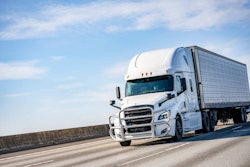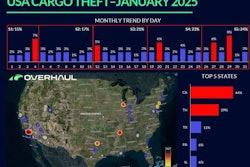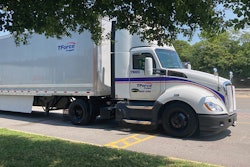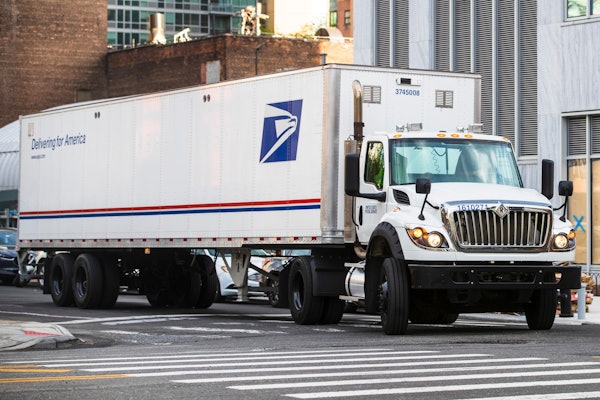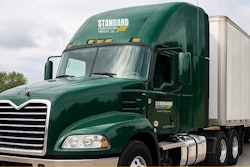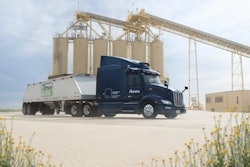The end of 2024 saw fleets face profitability challenges due to rising operational costs, including higher driver wages, maintenance expenses, and insurance claims, which impacted margins despite some revenue growth.
Market conditions remained weak for many carriers, with lower freight volumes and pricing pressures affecting earnings, though some executives noted signs of market improvement and expressed cautious optimism.
Find reports on the earnings of major publicly traded carriers below.
Operating expenses, Hurricane Helene dents Covenant’s financial performance
Covenant (CCJ Top 250, No. 36) President Paul Bunn said higher truckload operating expenses impacted the quarter, rising 6.6% per mile year-over-year. In analysts call, Bunn elaborated that dedicated segment underperformed, with margins declined both annually and sequentially, driven by customer shutdowns, operational issues, Hurricane Helene, and mid-week holidays. Increased driver wages, claims expenses, and maintenance costs also weighed on results.
The average age of its tractors slightly increased to 20 months compared to 19 months a year ago, which CEO David Parker said reflects the company’s focus on expansion while optimizing fleet uptime and costs.
Revenue: 2024 Q4: $277 million vs. 2023 Q4: $274 million
2024 YTD: $1.13 billion vs. 2023 YTD: $1.103 billion
Income: 2024 Q4: $6.7 million vs. 2023 Q4: $12.8 million
2024 YTD: $35.9 million vs. 2023 YTD: $55.2 million
-
Forward Air’s cost-cutting strategies marks integration progress
Forward Air (No.31) makes progress in its post-acquisition integration of Omni Logistics, with the achievement of $100+ million in annualized cost synergies, exceeding the initial $75 million target. The Omni Logistics segment reported its best quarterly reported EBITDA since acquisition, while the Intermodal segment maintained steady performance and improved income from operations compared to a year ago.
CFO Jamie Pierson noted that the Expedited Freight segment was negatively impacted by a pricing strategy put in place before the acquisition that “focused more on growing volume than profitability,” as well as a decrease in volumes in line with the LTL market.
Revenue: 2024 Q4: $632 million vs. 2023 Q4: $338 million
2024 YTD: $2.4 billion vs. 2023 YTD: $1.37 billion
Income: 2024 Q4: $(35) million vs. 2023 Q4: $(14) million
2024 YTD: $(1.1) billion vs. 2023 YTD: $42.8 million
-
Heartland Express’ operating ratio makes improvement, though a long way to go
Heartland Express (No. 25) reported a net loss of $1.9 million for the quarter. CEO Mike Gerdin said that lower freight volumes, freight rate mix, and an increase in empty miles compared to the same quarter a year ago reflected ongoing freight market weakness, though supply-demand dynamics improved slightly from Q3 to Q4 2024.
In 2022, the company incurred substantial debt to acquire CFI and Smith Transport and had noted integration challenges. In Q4, it has since made progress, contributing to an improvement in operating ratios, though Gerdin said it “remains significantly below” historical financial performance and financial and operational targets.
As of December 31,2024, the average age of the company’s tractor fleet was 2.5 years, compared to 2.2 years during the same period last year. The average age of the trailer fleet was 7.4 years, compared to 6.4 years on the same period in 2023.
Revenue: 2024 Q4: $242.6 million vs. 2023 Q4: $275 million
2024 YTD: $1.04 billion vs. 2023 YTD: $1.2 billion
Income: 2024 Q4: $(1.8) million vs. 2023 Q4: $5 million
2024 YTD: $(29.7) million vs. 2023 YTD: $14.7 million
-
J.B. Hunt expects insurance and labor costs to increase
J.B. Hunt (No. 3) posted a 2% increase in earnings, whilst revenue fell at 5%. CEO Shelly Simpson said 2024 was a “continuation of the challenging freight environment.” The company cited ongoing inflationary cost pressures, such as insurance premiums and hiring costs, which are projected to continue in 2025. CFO John Kuhlow noted these costs will need to be passed on to shippers and eventually consumers.
The company’s intermodal segment showed strength, representing 51% of revenue in Q4, even faced with some operational challenges. It aims to utilize increased customer demand and capacity expansions -such as the acquisition of Walmart’s intermodal assets- to improve financial performance.
Revenue: 2024 Q4: $3.15 billion vs. 2023 Q4: $3.3 billion
2024 YTD: $12.09 billion vs. 2023 YTD: $12.82 billion
Income: 2024 Q4: $155.5 million vs. 2023 Q4: $153.5 million
2024 YTD: $571 million vs. 2023 YTD: $728 million
-
Knight-Swift saw revenue decline, though LTL segment grew
While freight rates and inflation have brought negative impacts, Knight-Swift (No. 4) CEO Adam Miller said on a call with analysts that the company’s leadership has been using the down cycle to reinvest in the business by utilizing acquisitions to improve in TL and LTL markets. Knight-Swift saw revenue decrease 3.5%, though LTL revenue increased 20.2%, amid a 13.3% increase in shipments per day. The LTL segment included the recent acquisition of DHE Transportation, wherein the company has opened 37 additional service centers and 14 facilities.
Logistics segment revenue also increased 2.1% year-over-year, as well as Intermodal at 4.9%, though truckload decreased 4.4%, due to a 3.7% reduction in loaded miles.
In its truckload segment, the average age of the tractor fleet 2.6 years, compared 2.5 years in the same quarter of 2023. In its LTL segment, the average age of the tractor fleet was 4.2 years in Q4 2024, and 4.4 years in the same period in 2023.
Revenue: 2024 Q4: $1.86 billion vs. 2023 Q4: $1.93 billion
2024 YTD: $7.41 billion vs. 2023 YTD: $7.14 billion
Income: 2024 Q4: $77.9 million vs. 2023 Q4: $18 million
2024 YTD: $243 million vs. 2023 YTD: $338 million
-
Landstar achieves year-over-year revenue growth
Landstar (No. 10) achieved year-over-year revenue growth for the first time since Q3 2022. President and CEO Frank Lonegro said, “It was achieved via a sequential increase in overall truck pricing as compared to the 2024 third quarter and a strong revenue performance specific to our unsided/platform service offering.” It also achieved a 3.1% increase in overall truck revenue per load in Q4, compared to the same period in 2023.
However, Landstar also faced challenges with a 3.4% dip in the number of loads hauled via truck compared to Q4 2023. It also saw increased insurance and claim costs (up approximately 10.26%) due to increased cargo claims, impacting profitability. The company’s BCO truck count also decreased by approximately 10% year-over-year, noting challenges in retaining independent operators.
Revenue: 2024 Q4: $1.209 billion vs. 2023 Q4: $1.204 billion
2024 YTD: $4.8 billion vs. 2023 YTD: $5.3 billion
Income: 2024 Q4: $46 million vs. 2023 Q4: $58 million
2024 YTD: $196 million vs. 2023 YTD: $264 million
-
Marten Transport sees sequential improvement
Marten Transport (No. 37)’s Q4 results reported a decline in profit (down 61.8%) and revenue (down 14.1%), with operating expenses increased to 97.1%. However, Executive Chairman Randolph Marten expressed optimism as he pointed out that it was the first time since Q2 2022 that the company saw sequential improvement in net income, operating income and operating ratio, net of fuel surcharges. Marten also added that there was sequential increases in revenue per tractor, rate per total mile and miles per tractor within truckload and dedicated operations.
As of December 31, 2024, the carrier had a total of 3,006 tractors, compared to 3,349 tractors in Q4 2023. The average age of tractors was 1.9 in both periods. Total trailers in December 2024 were 5,440, while in the same period last year, it was 5,653 trailers. The average age of trailers were 5.3 years versus 4.6 years last year.
Revenue: 2024 Q4: $230 million vs. 2023 Q4: $268 million
2024 YTD: $963.7 million vs. 2023 YTD: $1.1 billion
Income: 2024 Q4: $5.6 million vs. 2023 Q4: $12.3 million
2024 YTD: $26.9 million vs. 2023 YTD: $70.3 million
-
Old Dominion Freight Line highlights operational efficiency
Old Dominion Freight Line (No. 9) revenue declined 7.3% year-over-year due to a decrease in volumes, reflecting the “continued softness in the domestic economy.” President Marty Freeman noted that the company’s market share remained “relatively consistent while we continued to strengthen our customer relationships.”
Despite volume challenges, it maintained a 99% on-time performance and 0.1% cargo claims ratio. It reported a 4.5% increase in LTL revenue per hundredweight, though its LTL tons per day decreased by 8.2% in the fourth quarter. The company’s operating ratio increased to 75.9%, due to revenue decline and rising overhead costs. Insurance and claims expense (up 2.9%) also increased, driven by adjustments recorded for its annual third-party actuarial review of accident claims.
Revenue: 2024 Q4: $1.39 billion vs. 2023 Q4: $1.49 billion
2024 YTD: $5.81 billion vs. 2023 YTD: $5.86 billion
Income: 2024 Q4: $263 million vs. 2023 Q4: $322 million
2024 YTD: $1.18 billion vs. 2023 YTD: $1.23 billion
-
P.A.M. Transportation Services reports quarterly and annual losses
P.A.M. Transportation Services (No. 58) reported quarterly a loss of $31.57 million from a loss of $2.23 million in the same period in 2023. Revenues declined by 7.56% to $166.53 million from $180.16 million. President Joe Vitiritto declined to give a statement regarding the report.
According to the report, the company recorded a $6.4 million impairment charge “to align the carrying value of revenue equipment to market values of used equipment, which have declined throughout 2024.”
Empty miles increased to 9.7% from 9.2%, compared to the same period in 2023, while revenue per mile also declined 5 cents to $2.10. Total loads fell to 94,778 from 94,776. Average company trucks declined to 1,754 from 1,938. Average owner-operator trucks increased from 299 to 510.
Revenue: 2024 Q4: $166.5 million vs. 2023 Q4: $180.16 million
2024 YTD: $714.6 million vs. 2023 YTD: $810.8 million
Income: 2024 Q4: $(31.57) million vs. 2023 Q4: $(2.23) million
2024 YTD: $(31.6) million vs. 2023 YTD: $18.4 million
-
Schneider National sees improvement in intermodal segment
Schneider National (No. 8) President and CEO Mark Rourke said that “signs of seasonality” returned to the freight market and were even more evident in Q4 as carriers continued to exit the market and demand aligned to seasonal expectations.
Intermodal achieved its second consecutive quarter of year-over-year growth, with continued improvement in volume and revenue per order, Rourke added. The Dedicated segment saw organic fleet growth and completed its acquisition of Cowan Systems in December. It also saw significant reductions in DOT reportable accidents, achieving an all-time low accident frequency.
Revenue: 2024 Q4: $1.3 billion vs. 2023 Q4: $1.4 billion
2024 YTD: $5.29 billion vs. 2023 YTD: $5.49 billion
Income: 2024 Q4: $32.6 million vs. 2023 Q4: $27.4 million
2024 YTD: $117.0 million vs. 2023 YTD: $238.5 million
-
Saia sets revenue record, though increased operational challenges
Saia (No. 19) President and CEO Fritz Holzgrefe noted the company’s progress in the year, as it achieved a 5% year-over-year increase in revenue, setting the company’s record for Q4 results. However, operating ratio increased to 87.1% in Q4, compared to 85% a year ago, noting increased operational challenges. It also opened 21 new terminals and relocated nine others, as well as onboarded new talent. 2024 also marked a record year for equipment, Holzgrefe said, as they had serviced over 6,000 trailers. “This investment in our fleet allows us to better service our customers and provide unique solutions for their needs.”
LTL shipments per workday increased 4.5% in Q4 compared to the same period in 2023, while LTL revenue per shipment increased 1.3%. LTL tonnage per workday increased 8.3%, and LTL revenue per hundredweight decreased 2.3%.
Revenue: 2024 Q4: $788.9 million vs. 2023 Q4: $751 million
2024 YTD: $3.2 billion vs. 2023 YTD: $2.8 billion
Income: 2024 Q4: $76 million vs. 2023 Q4: $89 million
2024 YTD: $361 million vs. 2023 YTD: $354.8 million
-
Werner sees signs of improving environment
Werner (No. 14) saw quarterly revenues down 8% and net income down 50%. While the market continues to indicate challenges, Derek Leathers, Chairman and CEO, noted early signs of an improving market. One-Way revenue per total mile increased year-over-year for the second consecutive quarter, while the dedicated segment’s average fleet size grew sequentially.
Though insurance expense (up approximately 14.57%) was elevated due to “unfavorable development on large dollar claims,” Leathers said the company’s safety metrics remain near record levels. “During this downturn, we have focused on controlling what we can by investing in ourselves and making strategic decisions that position us favorably for creating long-term value for our shareholders as conditions improve.”
Revenue: 2024 Q4: $754.7 million vs. 2023 Q4: $821.9 million
2024 YTD: $3.03 billion vs. 2023 YTD: $3.283 billion
Income: 2024 Q4: $11.8 million vs. 2023 Q4: $23.5 million
2024 YTD: $33.5 million vs. 2023 YTD: $112.3 million
-
XPO ends Q4 strong
XPO (No.7) reported a revenue of $1.92 billion, compared with $1.94 billion for the same period in 2023. The decrease was due primarily to lower fuel surcharge revenue in the North American LTL segment, the report said. CEO Mario Harik commented on the company’s strong fourth quarter year-over-year earnings and LTL margin expansion that “outperformed the industry.”
The carrier also improved its on-time performance year-over-year for the 11th consecutive quarter. Harik also noted the company’s network investment, including 25 new service centers online last year, and expanding network capacity. XPO also invested in purchasing tractors and manufacturing its own trailers.
“We ended 2024 with an average fleet age of 4.1 years, giving us one of the youngest tractor fleets in the industry,” Harik said. “As a result, we’re operating our fleet at a lower cost per mile. Because we made these strategic investments throughout 2023 and 2024, we currently have nearly 30% excess door capacity and a robust fleet in the trough of the cycle.”
Revenue: 2024 Q4: $1.92 billion vs. 2023 Q4: $1.94 billion
2024 YTD: $8 billion vs. 2023 YTD: $7.7 billion
Income: 2024 Q4: $76 million vs. 2023 Q4: $58 million
2024 YTD: $387 million vs. 2023 YTD: $192 million



